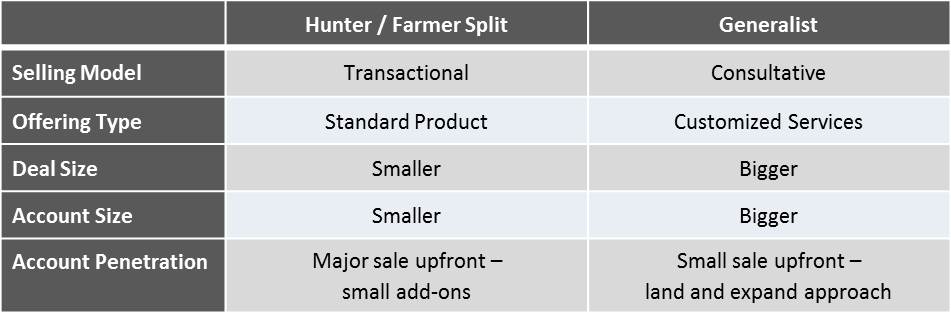Hunters, Farmers or Generalists?
What Coverage Model is Best for Your Business?
Which type of sales role does your sales force need? What do you have today? Is it the right one? The question about “hunting” versus “farming” is an age-old sales coverage model debate. Most sellers consider themselves “hunters.” After all, hunting gets the glory. Landing the new account garners more press than servicing the existing customer. The “farmers” faithfully harvest repeat business from existing accounts. But is it really that black and white? Usually, the answer is “No.” Sales roles are far more nuanced than simply hunting versus farming. In fact, the Alexander Group tracks and benchmarks a set of over 85 unique types of selling roles. But for simplicity’s sake, let’s explore the basic hunting/farming versus generalist coverage options.
Hunter vs Farmer vs Generalists Sales Model
Most sales leaders aim to hire a sales staff of hunters to acquire new accounts and/or get more business from existing accounts. If the sales job is a pure hunter, a clean handoff to a capable customer support team, renewals team or “farmer” sales role is required to handle the ongoing account needs (assuming there are ongoing account needs). Many organizations deploy a hybrid hunter/farmer role, sometimes referred to as a Generalist or an Account Manager. This approach gives the sales leader the flexibility to deploy this role across a wide range of geographies and account portfolios with different mixes of business. The downside of this approach is lack of focus. The generalist might become a “jack-of-all-trades, master of none,” as the saying goes. Or worse, the generalist can get caught up in post-sales activities such as contracting, billing, shipping, customer support, customer service, and the like, resulting in little to no time for hunting. And so the sales leader is faced with a choice to either A) deploy the more flexible but potentially less growth-oriented Generalist and drive hunting focus through management and compensation, or B) create a pure hunting role to focus on new business, or possibly C) do both.
How should sales leaders determine the right model for their sales force? Should the decision be based on company size and maturity, or the type of product or service, or the nature of the selling process, or the type of customer, or the complexity of the sale, or the personality types of their sales reps or other factors? We encounter these questions in our work with clients across multiple industries, and while a complete answer is beyond the scope of this article (as it can and often is influenced by ALL of the above factors), there are some practical guidelines to consider when deciding between a Generalist versus a Hunter/Farmer model, as follows:
Hunter/Farmer Split Model
The split model achieves the desired focus on hunting. It is best suited for offerings that are already or more easily understood by the marketplace, have a more quantifiable value to the customer, and thus are more of a “known quantity.” These offerings therefore generally require less of a consultative sales effort. They may represent big offerings sold to big accounts but are usually smaller in deal size. The sales effort is highly “front-loaded,” meaning once the first sale is made there is less ongoing selling to be done. The type of separate farmer role needed will depend on these same factors – the more these factors are true (transactional, standard, smaller, up-front) frankly the less a farmer job is even needed and a simple customer services or support organization will suffice.
Generalist Model
Newer offerings services that require more missionary or visionary selling and thus a higher degree of trust in the value or impact of the offering are often better served by the Generalist. In these instances the customer expects the sales person to stay more involved past the initial sale to address lingering doubts or ambiguity and to ensure ultimate success. In many cases the customer forms a bond with the sales person based on trust. The offerings are typically more complex, involving more on-going services. Quite often the first sale is just a starting point for the relationship. The Generalist aims to establish a “beachhead” in the account from which to expand into other parts of the customer’s organization, maintaining and growing relationships and the business over time.
What about both?
Some sales leaders will deploy both models against the same customer segment, typically with pure Hunters assigned to green territories and Generalists covering established territories. In most cases of this nature the successful Hunter transitions over time into a Generalist.
What if I have a highly consultative sale but really need more hunting sales focus? Are there situations that call for a hunter/farmer split model with a complex sale? Sales leaders desiring greater hunting focus can deploy pure hunters in a consultative sale. But in these instances, the type of farmer model and the “hand-off” process needs to be carefully designed and managed. It is a more expensive model, but may be appropriate based on the customer lifetime value and the margins in the business.
Can I redeploy my farmers as hunters, or vice-versa? Sales leaders with any experience with chuckle at this thought. Yes it’s possible to redeploy farmers as hunters, or hunters as farmers, but it usually doesn’t work. Most sales people fall toward one end of the selling versus servicing spectrum. This is another reason why the generalist model is challenged. True hunters get frustrated with having to devote time to servicing accounts. Meanwhile natural farmers will thrive in service activities and will avoid hunting until absolutely necessary. What role(s) you decide you need will have a direct impact on your recruiting profile and your compensation program for each role. Sales personality types vary significantly between hunters and farmers.

Contact Us
Learn more about designing the best sales coverage model for your sales force.

